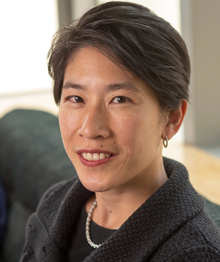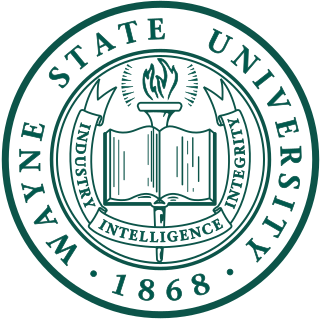Melissa G. Trainer is an American astrobiologist who in 2004 demonstrated empirically that life could have formed on Earth through the interaction of methane, carbon dioxide and ultraviolet light (sunlight). She is currently Assistant Chief for Science, Operations, and Strategic Planning in the Planetary Environments Laboratory at NASA's Goddard Space Flight Center.

Darleane Christian Hoffman is an American nuclear chemist who was among the researchers who confirmed the existence of Seaborgium, element 106. She is a faculty senior scientist in the Nuclear Science Division of Lawrence Berkeley National Laboratory and a professor in the graduate school at UC Berkeley. In acknowledgment of her many achievements, Discover Magazine recognized her in 2002 as one of the 50 most important women in science.

Mildred Cohn was an American biochemist who furthered understanding of biochemical processes through her study of chemical reactions within animal cells. She was a pioneer in the use of nuclear magnetic resonance for studying enzyme reactions, particularly in Adenosine triphosphate (ATP). She received the nation's highest science award, the National Medal of Science, in 1982.
Joanna S. Fowler is a Scientist Emeritus at the U.S. Department of Energy's Brookhaven National Laboratory in New York. She served as Professor of Psychiatry at Mount Sinai School of Medicine and Director of Brookhaven's Radiotracer Chemistry, Instrumentation and Biological Imaging Program. Fowler studied the effect of disease, drugs, and aging on the human brain and radiotracers in brain chemistry. She has received many awards for her pioneering work, including the National Medal of Science.

Susan Solomon is an atmospheric chemist, working for most of her career at the National Oceanic and Atmospheric Administration. In 2011, Solomon joined the faculty at the Massachusetts Institute of Technology, where she serves as the Ellen Swallow Richards Professor of Atmospheric Chemistry & Climate Science. Solomon, with her colleagues, was the first to propose the chlorofluorocarbon free radical reaction mechanism that is the cause of the Antarctic ozone hole.

Jeehiun Katherine Lee is an organic chemist and a Professor in the Department of Chemistry at Rutgers University. She currently runs a research lab on the New Brunswick campus.
Alice Yen-Ping Ting is Taiwanese-born American chemist. She is a professor of Genetics, Biology, and Chemistry at Stanford University. She is also a Chan Zuckerberg Biohub investigator.
Angela K. Wilson is an American computational, theoretical, and physical chemist. She is currently the John A. Hannah Distinguished Professor of Chemistry in the department of chemistry of Michigan State University. Previously she was professor of computational chemistry and co-director of the Center for Advanced Scientific Computing and Modeling (CASCaM) at the University of North Texas. She was Associate Vice Provost for Faculty at the University of North Texas, where she led the Office of Faculty Success, working with ~2,400 faculty through February 2016, when she moved to Michigan State University (MSU). In March 2016, Wilson began a position as the Chemistry Division Director of the National Science Foundation, while concurrently on the MSU faculty.

Paula Hammond is a David H. Koch Professor in Engineering and the Head of the Department of Chemical Engineering at the Massachusetts Institute of Technology (MIT). Her laboratory designs polymers and nanoparticles for drug delivery and energy-related applications including batteries and fuel cells. She is an intramural faculty member of the Koch Institute for Integrative Cancer Research and an Associate Editor of ACS Nano.

Catherine Clarke Fenselau is an American scientist who was the first trained mass spectrometrist on the faculty of an American medical school; she joined Johns Hopkins School of Medicine in 1968. She specializes in biomedical applications of mass spectrometry. She has been recognized as an outstanding scientist in the field of bioanalytical chemistry because of her work using mass spectrometry to study biomolecules.

Teri W. Odom is an American chemist and materials scientist. She is the Chair of the Chemistry Department, Charles E. and Emma H. Morrison Professor of Chemistry, and a Professor of Materials Science and Engineering at Northwestern University.
Cornelia Denson Gillyard is an American organic chemist known for her work with chemicals in the environment.

Nancy B. Jackson is an American chemist. She has done energy research on heterogeneous catalysis and the development of alternative fuels. She also works in the field of chemical nonproliferation, educating chemical professionals on the importance of safe and secure chemical practice in research, teaching and business, in an effort to prevent the misuse of chemicals as "weapons, poisons, explosives or environmental pollutants". She was the first implementer in developing the international Chemical Security Engagement Program. She is active in promoting diversity in STEM fields. She was president of the American Chemical Society in 2011, leading the organization during the International Year of Chemistry. In 2012, she was honored with the AAAS Award for Science Diplomacy.
Allison A. Campbell is an American chemist who is known in the areas of biomineralization, biomimetics and biomaterials for her innovative work on bioactive coatings for medical implants. She is the acting associate laboratory director for the Earth and Biological Sciences Directorate at the Pacific Northwest National Laboratory (PNNL) of the Department of Energy. She previously served as director of the Environmental Molecular Sciences Laboratory (EMSL) at PNNL. She was elected as the 2017 president of the American Chemical Society (ACS).
Kelly Kenison Falkner is an American chemical oceanographer and educator. She is the Director of the National Science Foundation's (NSF's) Office of Polar Programs (OPP). Her work in the position led her NSF colleagues to name the Falkner Glacier, in Victoria Land, Antarctica, after her.

Cynthia J. Burrows is an American chemist, currently a Distinguished Professor in the Department of Chemistry at the University of Utah, where she is also the Thatcher Presidential Endowed Chair of Biological Chemistry. Burrows acquired a B.A. degree in Chemistry at the University of Colorado (1975). There she worked on Stern-Volmer plots in Stanley Cristol’s laboratory during her senior year. She continued to study physical organic chemistry at Cornell University, where she received a Ph.D. degree in Chemistry in 1982 working in Barry Carpenter’s laboratory. Her Ph.D. thesis work focused on cyano-substituted allyl vinyl ethers. Burrows then conducted a short post-doctoral research stint with Jean-Marie Lehn in Strasbourg, France. Burrows was the Senior Editor of the Journal of Organic Chemistry (2001-2013) and became Editor-in-Chief of Accounts of Chemical Research in 2014.,,
Sherry J. Yennello, Ph.D. is an American nuclear chemist and an Elected Fellow of the American Association for the Advancement of Science. She is a Regents Professor and the holder of the Cyclotron Institute Bright Chair in Nuclear Science, who currently serves as the Director of the Cyclotron Institute at Texas A&M University. She is also a Fellow of the American Chemical Society and the American Physical Society. She has authored as well as co-authored more than 530 peer reviewed journal articles and has conducted many invited talks, presentations and seminars at several prestigious academic conferences and scholarly lectures.

Lucio Frydman is an Israeli chemist whose research focuses on magnetic resonance imaging (MRI), nuclear magnetic resonance (NMR) and solid-state NMR. He was awarded the 2000 Günther Laukien Prize and the 2013 Russell Varian Prize. He is Professor and Head of the Department of Chemical and Biological Physics at the Weizmann Institute of Science in Israel and Chief Scientist in Chemistry and Biology at the US National High Magnetic Field Laboratory in Tallahassee, Florida. He is a fellow of the International Society of Magnetic Resonance and the Editor-in-Chief of the Journal of Magnetic Resonance.
Nina Matheny Roscher (1938—2001) was an American chemist and advocate for women and minorities in science. She also researched the history of women in chemistry, publishing the book Women Chemists (1995). She served as professor and chair of the chemistry department at American University in Washington, D.C. She received the ACS Award for Encouraging Women into Careers in the Chemical Sciences (1996) and the Presidential Award for Excellence in Science, Mathematics and Engineering Mentoring (1998).

The Princeton University Department of Chemistry is an academic department at Princeton University. Founded in 1795, it is one of the oldest departments of chemistry in the country and is consistently funded by grants from the National Science Foundation and the National Institutes of Health. In 2010, the department moved to its new location, the Frick Chemistry Laboratory. The department oversees the undergraduate, graduate, and post-doctoral programs in chemistry, as well as a number of research centers and initiatives at the university.




















